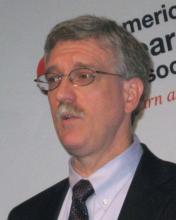Omecamtiv mecarbil, a member of the novel myotropic drug class that improves cardiac performance, safely produced a significant but modest improvement in heart failure events or cardiovascular death in a pivotal trial with HFrEF patients, leaving experts unsure about the role this drug could have on top of an already crowded list of four first-line drug classes for this condition.
“It remains to be investigated and discussed where omecamtiv mecarbil fits in” the overall approach to treating patients with heart failure with reduced ejection fraction (HFrEF), commented Paul Heidenreich, MD, designated discussant for the report at the virtual scientific sessions of the American Heart Association.
Omecamtiv mecarbil (OM) treatment produced a positive result for the study’s primary endpoint, with a 2.1% absolute cut in the combined rate of cardiovascular death, first heart failure hospitalization, or first urgent visit for heart failure compared with placebo during a median follow-up of about 22 months This represented an 8% relative risk reduction, reported John R. Teerlink, MD, at the meeting, and broke down as a 0.6% absolute drop in cardiovascular death compared with the placebo arm, a 0.7% cut in heart failure hospitalization, and a 0.8% drop in urgent outpatient visits for heart failure. Dr. Teerlink and his associates called this benefit “modest” in their simultaneous publication in the New England Journal of Medicine.
Room for a fifth HFrEF drug?
In addition to the limited benefit, another question raised by the trial is how OM would perform when used on top of what is now considered standard, quadruple therapy for most HFrEF patients: a beta-blocker, a mineralocorticoid receptor antagonist, sacubitril-valsartan (Entresto), and an agent from the sodium glucose co-transporter 2 (SGLT2) inhibitor class, specifically dapagliflozin (Farxiga) or empagliflozin (Jardiance). During the period when the new OM trial was run, 2017-2019, the SGLT2 inhibitors had not yet been established as a key part of standard HFrEF treatment, and hence fewer than 3% of enrolled patients were on one of these drugs.
Because of this evidence gap, OM “can’t be across the board a fifth drug on top of standard treatment,” based on the new results, cautioned Dr. Heidenreich, a cardiologist and professor of medicine at Stanford (Calif.) University School of Medicine.
The new evidence for OM’s efficacy is “not compelling” when compared with what dapagliflozin and empagliflozin each showed in recent trials, with the SGLT2 inhibitors producing about a 25% cut compared with placebo in a primary outcome that was similar to the one used in the OM trial, commented Douglas L. Mann, MD, a heart failure physician and professor of medicine at Washington University School of Medicine in St. Louis. “Would OM still show a benefit with an SGLT2 inhibitor? That’s not known” on the basis of the available data, he said in an interview.
A related factor that could influence potential use of OM in routine practice is that with four established, foundational drug classes, adding a fifth drug that will only be available in a branded formulation raises issues of incremental cost and compliance issues, Dr. Mann noted.
The positives of omecamtiv mercarbil
But in addition to its positive result in the GALACTIC-HF trial, treatment with OM showed other attractive characteristics in a study that treated a wide spectrum of 4,120 patients with HFrEF as well as including 4,112 patients randomized to placebo. Most notably, OM had a very clean safety profile, with adverse event rates similar to placebo patients across all adverse event subtypes, as well as causing no drop in blood pressure and actually an average 2.0–mm Hg increase in systolic blood pressure, no increase in potassium, no apparent impact on renal function, and a small but significant decline in N-terminal pro-B-type natriuretic peptide (NT-proBNP) compared with placebo.
This coupled with the novel mechanism of action of OM – direct augmentation of cardiac sarcomere function by increasing myosin attachment to actin – suggests that OM can be safely added on top of existing HFrEF treatment to provide an unique and incremental benefit.
“Other heart failure drugs [like beta-blockers and sacubitril-valsartan] lower blood pressure, so what can happen is that clinicians run out of room to add full dosages” when patients’ pressures fall too low, commented Gregory D. Lewis, MD, head of Heart Failure at Massachusetts General Hospital in Boston. He is principle investigator for another OM trial, METEORIC-HF, which is examining the possible impact of the drug on exercise capacity in a randomized study with about 270 HFrEF patients.
If the METEORIC-HF results can could confirm some of the GALACTIC-HF results that suggested improvements in patient function, the combined data could potentially lead to regulatory approval for U.S. marketing of the drug, Dr. Lewis suggested. Results from that study are expected in 2021, he said in an interview.
The GALACTIC-HF results hinted at possible functional improvement after 24 weeks on treatment among patients who required hospitalization as measured by the Kansas City Cardiomyopathy Questionnaire, which measures quality life. However, this difference failed to meet the study’s prespecified definition of a significant effect.
Another intriguing suggestion of focused benefit was in patients with a left ventricular ejection fraction at or below the median in GALACTIC-HF of 28%. In that subgroup, OM treatment was linked with a significant 16% relative reduction in the primary endpoint compared with placebo, while it had no significant effect in the other 50% of patients with higher ejection fractions. (The maximum left ventricular ejection fraction for enrollment was 35%.) This apparent subgroup interaction was statistically significant, reported Dr. Teerlink, a professor of medicine at the University of California, San Francisco, and director of Heart Failure at the San Francisco V.A. Medical Center.
Further analysis of the study data “will provide greater insight into subgroups who may demonstrate greater benefit, such as patients with lower ejection fraction in whom improving cardiac function may have a greater role,” he said. The idea that a drug that improves myocyte function at the molecular level could especially benefit patients with the lowest ejection fractions is “biologically plausible,” Dr. Teerlink said.
This scenario looks reasonable, and could make OM something of a niche drug for at least the near term, said Dr. Mann.
The world’s first myotropic drug
Possibly the most notable aspect of GALACTIC-HF is that it proved the efficacy, modest though it was, of a novel drug mechanism that fulfills a decades-long quest of heart failure researchers: a safe way to improve the heart’s pumping action.
“For years, the heart failure community struggled with treatment to improve cardiac performance, but invariably it ended in disaster by worsening cardiac deaths,” problems that led to abandonment of early inotropic drugs more than a generation ago, noted Dr. Mann.
But a more nuanced approach to inotropic agents recently has emerged from Dr. Teerlink and his associates, built on the premise that the dangers seen years ago related to the calcium modulations they caused. Their new paradigm is that the dangers of these “calcitropic” agents can be sidestepped with different agents that either mediate their effects via myosin, the myotropes like OM, or mitochondrial effects from mitotropic drugs.
The inotrope debacle from the 1990s made that drug-class name “a dirty word that causes fear and loathing in the heart failure community,” observed Dr. Mann. While the term myotrope has not yet really caught on, “If omecamtiv mecarbil starts getting used in routine practice, then I think you’ll start seeing uptake of the term myotrope,” he predicted.
GALACTIC-HF was sponsored by Amgen, Cytokinetics, and Servier, the companies developing omecamtiv mecarbil. Dr. Teerlink has received research support from and been a consultant to Amgen, Cytokinetics, and Servier, as well as Abbott, AstraZeneca, Bayer, Boehringer Ingelheim, Bristol-Myers Squibb, Medtronic, Merck, and Novartis. Dr. Heidenreich had no disclosures. Dr. Mann is on a steering committee for a trial sponsored by Novartis and has no other commercial disclosures. Dr. Lewis is principal investigator for a trial of omecamtiv mecarbil and has no other commercial disclosures.
On Twitter @mitchelzoler



